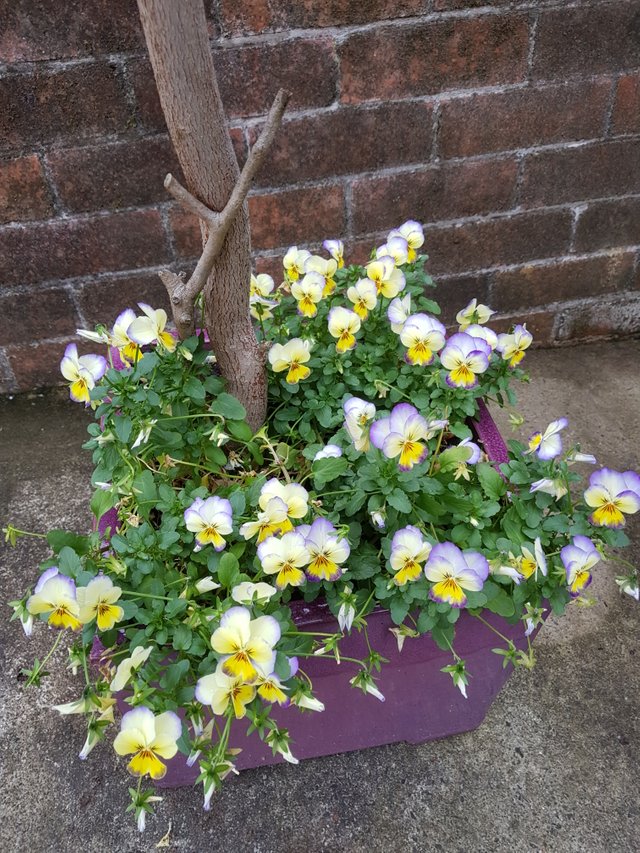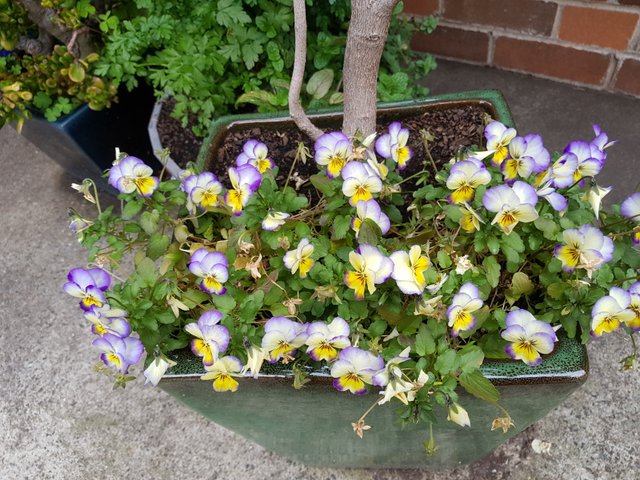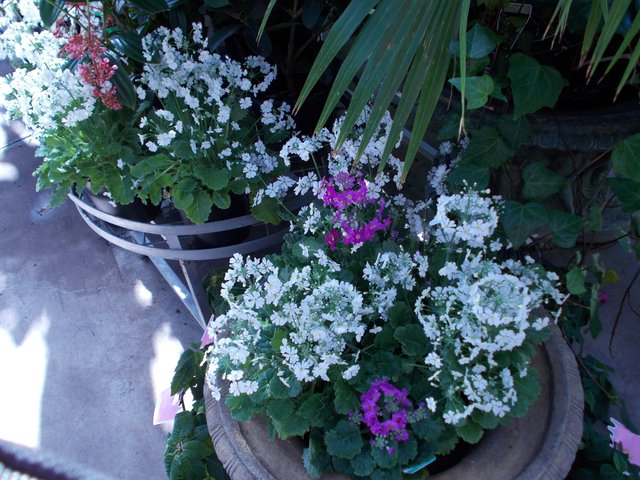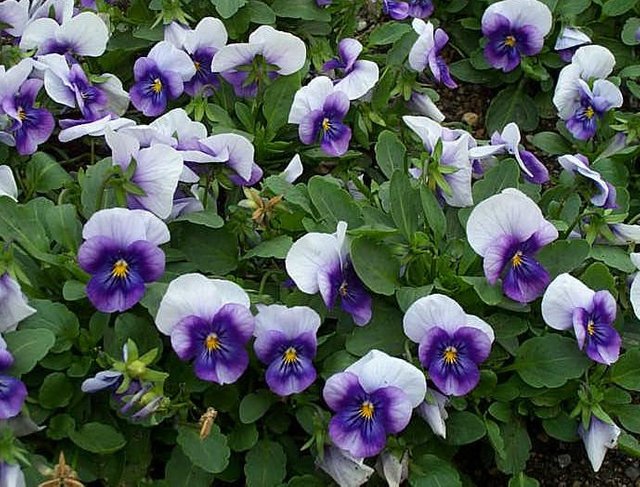Violas and Primulas.
Violas are a diverse group of plants. The flowers are roughly similar across all species, but some are annuals ( last only one growing season ) and some are Perennials ( lasting more than one season ). Here, we focus on the Annual variety. These have many common names, like Pansies, Johnny-jump-ups, etc and there are many hybrids available as seedlings in Nurseries and Garden Centres. They come in a fantastic range of colours and combinations of colours. Plant them in a sunny spot. They really are like "eye candy" !! I saw these Violas growing in pots inside a carport while on a walk around the suburbs.

Primula are also a great Annual plant that is available for Winter planting. These prefer a semi-shaded spot out of the hot sun. Colours available include crimson, pink, white,blue and purple. They grow and flower quickly to give a beautiful display, and they also self-seed, so you are likely to continue to have them year after year. There are also Perennial Primulas , but they are not nearly as popular as the annuals. These Prumula were growing in pots at a Garden Centre in Northern Sydney.

The trial of winter-flowering pansies (violas are excluded) currently under way at the Royal Horticultural Society's garden at Wisley includes an amazing 254 different cultivars.
An initial lesson that I took from my time spent on RHS trials judging panel is that, in early winter at least, the small-flowered pansies, which are closer in style to violas, have been more impressive than those with larger flowers. Nine small flowers look far more colourful than two large ones.
https://static1.squarespace.com/static/50db5688e4b00220dc71db15/t/5501aadfe4b0e9c7f82cc9e6/1426172643018/?format=500w
This is why. First, the flowers of many pansies are so large that the petals simply do not have the strength to support themselves. The tops of the flowers hang over, the effect is lost.

Violas, on the other hand, produce such a constant succession of flowers, if one is damaged by the weather another soon opens. And, with alpine species in their ancestry, violas are simply tougher.
Seeing so many winter-flowering pansies together on dull winter days led me to another conclusion: dark colours make no impact. Crimson, deep purple and dark blue, especially if they feature black-blotched faces, never really stand out, but white, primrose, sky blue and pale pink sparkle on even the most overcast days.
In garden centres, or when ordering seed for next season from catalogues, names to look out for amongst violas include 'Sorbet' (24 colours and colour combinations, and probably the most prolific), 'Penny' (25 colours), 'Velour' (23 colours) and 'Angel' (33 colours).
source
Fav. comment Award !! Well done for choosing great Pics.
Violas are an early blooming plant. These perennials are often grown as an annual. Most people believe they are annuals. They are early bloomers in late spring to early summer. Then, shrivel in the mid summer heat.
They are native to the southern hemisphere. Easy to grow, you will often find Violas growing in the wild, in their native regions.
There are so many different types of primulas, it’s difficult to choose which ones to go for. There are taller varieties such as the lollipop-shaped flowers of Primula denticulata, which come out a bit later, or the traditional, more familiar types such as the primrose and the cowslip.
They are really easy to grow, flourishing in virtually any situation provided they are planted in rich soil, although cowslips favour free-draining soil and the Asiatic types provide a riot of colour in heavy soil.
http://www.gardenersnet.com/flower/viola.htm
https://www.irishexaminer.com/breakingnews/lifestyle/our-guide-to-growing-perfect-primulas-and-how-to-make-the-most-of-these-colourful-plants-833222.html
Up to your usual high standard ! :)
Perennial violas look a lot like their cousins, pansies. But, perennial violas offer the benefit of coming back year after year, adding early-season color to the garden, as well as lots of curb appeal first thing in the season when relatively few other plants bloom. Perennial violas bloom in a wide range of colors, and have a soft, old-fashioned feel that makes them ideal for use in cottage gardens. Because these spring flowers are low growing, they're excellent choices for the front of the border or lining walkways and sidewalks. Hardiness varies by variety; if you live in an especially cold-winter area, be sure to check the hardiness before planting.
Grow perennial violas in full sun (at least 6 to 8 hours each day) or partial shade. Most varieties can grow quite well in shade, but don't bloom as profusely. Water perennial violas enough to keep the soil moist, but not wet. Though these spring-flowering plants can tolerate some drought, they look better -- and bloom better -- with regular watering.
Primula are an easy to grow group of perennial plants which come in many different colours and shapes. Many people thinking of Primula will bring to mind the popular Polyanthus types illustrated left, but in fact there are many different types, shapes, sizes and colours of Primula and they are great garden plants.
Sources = http://www.costafarms.com/plants/viola-perennial
https://www.sundaygardener.co.uk/how-to-grow-primulas.html
Up to your usual high standard. :)
Source
The National Gardening Bureau picked violas as their flower of the year for 2007. Violas and pansies are such relied upon stalwarts that many gardeners take them for granted and think they know everything there is to know about them. True, violas are easy to care for plants.
Source
Source
But in the gardening world, nothing stands still. Newer varieties of violas are being introduced with bolder colors and larger flowers that bloom longer. Even better, they exhibit better heat and cold tolerance than the remarkably hardy varieties we're familiar with.
Source
Primroses are actually hermaphrodites - but they have 'pin' and 'thrum' flowers - one with short male parts and long female parts (pin), and the opposite for thrum. This is under genetic control.
primula eliator, pin
Source
I don't know if anyone has experimentally been able to overcome the genetic basis, but most likely if they did it would be impossible to duplicate inexpensively outside of a highly controlled laboratory setting.
primula eliator, trum
Source
Text Source
Violas are typically lower growing than pansies, with smaller, more abundant flowers. Many violas form a trailing habit and look fabulous in a hanging basket, patio pot or window box. Don’t be put off by their smaller size – in fact violas will produce more flowers per plant than a pansy! Here’s our step by step guide to fabulous violas.
Violas are profuse, low-growing cottage garden perennials. The colour combinations you can achieve are myriad – purples, lilacs, pinks, blues and magentas. Varieties available cover trailing violas, double-flowered and colour-changing flowers, as well as violas with particularly striking, variegated foliage. Viola flowers are also edible – you can add a dash of colour to a salad or as a garnish, or use them in jams, cakes or as decoration on the top of biscuits!
Source: https://www.gardeningdirect.co.uk/violas-guide
Primroses provide you with early spring blooms in almost every color of the rainbow. They prefer cool temperatures, a rich humus soil (lots of compost and leaf mold) and partial shade. They appreciate full sun in the spring, but must have semi-shade as the temperatures warm. They are quite tolerant of being transplanted, even when they are in bloom. They should be planted in a cool, partly shady area in the garden with rich, well-draining, slightly acid soil (pH 6.5). Primroses need to be planted so that their crown is right at soil level and at least six inches apart.
Source: http://www.missouribotanicalgarden.org/PlantFinder/PlantFinderDetails.aspx?kempercode=b564
Images uploaded from google.